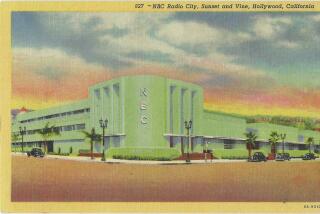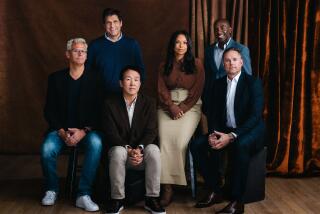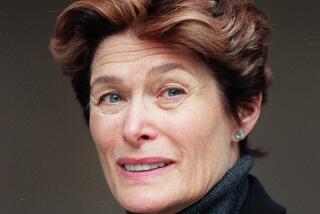Wave of the Future : Programming: Children’s radio is the coming thing--just ask Jimmy Freeman, a new network’s vice president of fun.
“I wanted to be a lot of things ever since I was a kid. I wanted to be an artist, a swimmer or a runner in the Olympics, I wanted to own a doughnut shop, I wanted to be an actor.”
Now, at the ripe age of 11, James (Jimmy) Freeman has a job many adults might envy: Who wouldn’t want to be a vice president of fun?
Freeman, who may be the youngest paid media executive in the country, was hired early this year by a national radio network that was looking for a way to grab listeners with up-to-the-minute current entertainment. . . . Listeners in a barely tapped market with big-time growth potential.
Seven-day-a-week, 24-hour-a-day children’s radio is the wave of the future, according to executives at Radio AHHS, the 2-year-old, Minneapolis-based station that forms the core of the new Children’s Satellite Network.
The network, a wholly owned subsidiary of Children’s Broadcasting Corp., began signing up major market affiliates in October, wooing them with a remarkably full 24-hour format including call-ins, storytelling, rock oldies, nighttime lullabies, drive-time variety shows, parenting tips, contests and community news. Negotiations with a Los Angeles affiliate are said to be close to completion.
Children’s radio isn’t new. A few stations allot small blocks of time for shows aimed at young listeners. In the Los Angeles area, “Halfway Down the Stairs With Uncle Ruthie” is a half-hour, 20-year-old, non-commercial Saturday morning fixture on KPFK-FM and Tim Arem’s “Morning Musical Menagerie” Sunday show expanded this year to two hours on KWINK-AM.
Infrequent attempts to establish full-time children’s programming, however, have failed. What makes CSN execs so sure they’ll succeed?
“I think when the idea first came up a few years ago, there wasn’t enough real programming you could put on the radio,” said Bill Barnett, CSN president.
Since then, the boom in children’s audio recordings featuring both artists who specialize in the field and big-name stars from Merle Haggard to Little Richard means that “we’ve got producers coming out of the woodwork wanting to do shows for us.”
The recent political emphasis on family values is another reason that “people are saying this is a perfect time for this kind of format,” Barnett added.
More significantly perhaps, advertisers have a growing interest in new ways to reach an audience that studies show has billions to spend and influences billions more in family purchases.
“Usually, when a new 24-hour-a-day format starts,” Barnett said, “it’s difficult to get stations on a long-term basis or in major markets to look at it, but we’ve already cleared in several major markets.”
On the air now are affiliates in Minneapolis, Phoenix and Salt Lake City. Others will begin airing shortly in Indianapolis, St. Louis, Washington, Denver, Baltimore and Abilene.
Several more across the country are close to signing, Barnett said, persuaded in part, he noted, by a 1992 marketing survey from Strategic Radio Research that tracked Radio AHHS’ performance in the Minneapolis area among families with young children.
According to Barnett, the survey rated Radio AHHS No. 1 in the market for under 10-year-olds, No. 8 for parents and No. 4 in afternoon drive.
“These numbers--if you were a buyer, your mouth would drop,” Barnett said. “Fifty percent of our listening is done in the car, and you know there aren’t a lot of 7-to-9-year-olds driving.”
That “captive audience,” Barnett said, is a plus for major advertisers looking for new marketing avenues.
“We’re going to put our emphasis in the top 100 to 150 markets,” he said. “People under 12 represent 20% of the country and our research shows that we have one parent for every two children listening. If you just take pure kid numbers we’re looking at a potential of 40 million kids. That doesn’t take into account the parents and grandparents who listen and the adult care and public venues we’re playing in.”
Barnett said that CSN is not afraid of possible competition if radio suddenly opens up as a children’s market. “We have nice advantages and in some ways it may be good for both parties--it would show advertisers out there that this works.”
Asked about the negatives inherent in advertising targeting children, Christopher Dahl, president of the Children’s Broadcasting Corp., said he intends to avoid the criticism leveled at television.
“Appropriateness is a critical aspect of what we’re doing,” Dahl said. “I’m not against advertising sugared cereals, I’m against advertising them in the manner television advertises them--it creates a greater image than reality.”
Radio AHHS has rejected certain promotional items and toy products “we felt were not appropriate,” Dahl said. He acknowledged that there is no way to control other stations’ advertising content, but that of the affiliates signed up so far, “not one of them disagrees with the direction we’re going.”
Dahl also said that he would not allow “the product to be run adjacent to inappropriate programming.” Recently, when a “shock or schlock, or whatever you want to call it, radio station called and wanted to put on our program on weekends, I said no.”
“We are giving the child a safe environment on a 24-hour-a-day, seven-day-a-week basis,” he said, “and it’s incumbent upon us to protect that for them.”
The network is, however, creating a three-hour “ancillary product” for “small radio stations.”
Dahl said he believes that the public, meaning parents who tune in, will serve as “almost an instantaneous monitor,” because in a medium “that’s devoted exclusively to kids, inappropriate material stands out a lot more.”
“We are somewhat strict,” said Barnett. “We’re not going to be so idealistic as to say we’re not going to take Coke or Pepsi or Oreos or Snickers,” but “we’ll take those on a limited basis. You’re not going to hear a candy bar or soft drink commercial every 15 minutes.”
“There’s always the potential for advertisers to manipulate children and we don’t want to be part of that,” said Michael Sweeney, president of Minneapolis-based Blockbuster Video, a Radio AHHS advertiser. It was his own 3-year-old and his partner’s three young children, he said, who convinced them of the station’s worth “before we ever found them as businessmen.”
“Frequently we’re asked how we can commit a large portion of our advertising to a radio station for children. Well, I don’t need to justify a buy based on Arbitron (a national ratings service). I can go to an event with 9,000 kids and tell you there are people listening to this radio station.” (Sweeney was referring to the well-attended “Kidstock” concert hosted recently by Radio AHHS at the 16,500-seat St. Paul Civic Center, featuring such popular children’s music artists as Bob McGrath of “Sesame Street,” Craig & Co., Joanie Bartels and Tom Chapin.)
Blockbuster’s ads contain child-pleasing humor, but target parents, Sweeney said, because “clearly children influence the purchase decision, but parents are the ultimate purchasers.”
For his part, Dahl tries to keep parents tuned in by making the station adult-friendly. “It certainly is a children’s radio station first and foremost, but it’s also an alternative to some programming on mainstream adult radio.
“We don’t report the details of traffic accidents and robberies, the music is all good music and disc jockeys say things that aren’t offensive to the audience.
“In everything we do,” Dahl said, “we look to the impact it will have on the child, from the music played and the contests we run, to what the on-air personalities say in general. We’ve rejected many records because we don’t think they’re beneficial to children.”
Hiring children along with adults is part of the network’s strategy to keep up with a child’s-eye view of the world. In addition to Freeman, the vice president of fun, there is a 16-year-old entertainment editor, plus other child staffers behind the scenes, learning the ropes.
One new program in the works is “a child’s news department, where kids will report on national interests. I’d love to get Chelsea Clinton on the air to talk about things from the perspective of the White House,” Dahl added wistfully.
Freeman gleefully describes his appointment to a “well-paying job that’s fun” as a matter of being in the right place at the right time.
He had been doing Radio AHHS promotion spots at the studio, he said, when “all of a sudden Bill Barnett, who is one of the big managers of Radio AHHS, he came in with the (then) program director Michael Jaye and they asked me if I would like to do the job where kids would call in and send in letters saying what they think would be fun for the station to do.”
The sixth-grader’s schedule includes “school Monday through Friday, piano two days a week and work every Friday from 4 to 7. I go in every second Saturday and sometimes I go in to make some commercials or do special stuff.” Both on the air and off, through call-ins and letters, the new vice president keeps tabs on what listeners want to hear. He expects to “start coming in maybe one more day a week” as response grows.
Freeman loyally rates Radio AHHS as “good for practically the whole family. Most of our songs have fun and variety and we try and play what the kids like to hear and lots of the songs have some sort of lessons in them.”
“I hope we can keep going for many years,” he added. “I want to stay with the station as long as I possibly can and maybe I’ll end up owning it or something.”
More to Read
The complete guide to home viewing
Get Screen Gab for everything about the TV shows and streaming movies everyone’s talking about.
You may occasionally receive promotional content from the Los Angeles Times.






